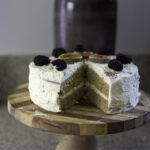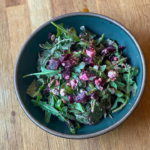Hello & welcome back to Food Science Fridays!
Last episode we talked about the texture and structure of frozen desserts, and experimented with crystal formation making a healthy frozen dessert. Our efforts resulted in a low fat, no added sugar peach frozen yogurt made from just 3 ingredients. It was great until I left it in the freezer for too long and it turned into a solid chunk of peach ice.
Today we are back for part 2 to discuss freezing point depression, and try out a no-churn vanilla custard recipe. Why no- churn? Well, I don’t happen to have an ice cream maker on hand, and I was super inspired by @CCC’s Curious Kitchen’s ice cream post the other day. By the way, for more food science, check out her instas and blog where she breaks down the science of beautiful baked goods!
Freezing Point Depression
Alright, so why did my peach frozen yogurt turn into a popsicle, and why doesn’t most ice cream turn into a block of ice when stored in the freezer?
The answer is something called Freezing point depression. Sound familiar anyone?
I learned about this way back in Gen Chem, and it’s the concept that the freezing point of a solution is lower than the freezing point of pure solvent. I won’t bore you with the actual equation, but look it up if you’re interested. Anyways, let’s break this down.
You probably know that pure water freezes at 0°C (32°F) (think of this as the solvent), but when you mix in a solute (something that is soluble in water like salt or sugar or alcohol), the freezing point will drop, and the more solute you add, the more the drop in freezing point. If you live somewhere where temps drop below freezing, you might notice that it’s common to salt the roads. Salt is used to keep the roads free from ice, so hopefully our cars don’t ice skate off the road. You may also notice that vodka or gin or some other hard alcohols don’t freeze in the freezer. That’s because 80 proof vodka is approximately 40% ethyl alcohol and 60% water. While pure ethanol has a freezing point of -114.1 °C (-173.5°F), vodka freezes somewhere in between, at approximately -24 °C (-11.2°F).
Also if you’ve ever made ice cream in a bag with salt crystals, that’s using this concept of freezing point depression to quickly solidify your ice cream!
What about the fat in ice cream?
Cream is made up mostly of water and fat, so how does the fat affect the freezing point?
It doesn’t! Oil (aka Fat) and water don’t mix, so the little fat bubbles that float around in the ice cream don’t interfere with freezing the way sugar, salt, or alcohol would. That being said, higher fat content does mean less water, so the texture may appear different.
So, what can we do to prevent the block of ice we ended up with last week?
Add sugar, salt, and or alcohol! I tried this recipe with various adjustments to the ingredients to alter the freezing temperature. See the various recipes below:
A home freezer typically ranges from from 0 to -20 °C. Mine is reading 1°F, which is about -17°C.
No Churn Frozen Custard Experiment 1: Just Sugar
Equipment
- stand mixer
Ingredients
- 170 g Heavy Whipping Cream (approximately 3/4 cup)
- 3 eggs Large (approximately 155 g)
- 100 g sugar (approximately 1/2 cup)
Instructions
- Whip the cream until thick enough to hold stiff peaks; the time will vary depending on the mixer. Transfer to a container and store in the refrigerator.
- Rinse the bowl and whisk, and wipe dry.
- Fill a pot with approximately 2 inches of water and bring to a boil. Lower heat to a simmer ( to maintain simmer I kept the heat very close to low). Place whole eggs and sugar in the bowl of a stand mixer, and whisk to combine. Place bowl over the steaming pot, making sure bottom does not actually touch the water. Whisk egg mixture constantly, and cook until a thermometer placed in the center of the egg mixture reads 160°F (71°C). This should take approximately 5 minutes.
- Transfer bowl to a stand mixer fitted with a whisk attachment (or use a hand held electric mixer). Whip on high speed until the mixture is at the ribbon stage: foamy, tripled or quadrupled in size, and about the consistency of soft serve ice cream. This should take anywhere from 5-10 minutes.
- Fold the prepared whipped cream into the egg mixture, working gently to incorporate it as thoroughly as possible without deflating or over mixing the base.
- Using a spatula, carefully scrape into a chilled container, cover, and freeze until firm enough to scoop.
- If you’re doing the experiment wait at least 8 hours before comparing your results.
Notes
No Churn Frozen Custard Experiment 2: Sugar + Salt
Equipment
- Electric mixer
Ingredients
- 170 g Heavy cream
- 3 large eggs
- 100 g sugar
- 2 g salt
Instructions
- Whip the cream until thick enough to hold stiff peaks; the time will vary depending on the mixer. Transfer to a container and store in the refrigerator.
- Rinse the bowl and whisk, and wipe dry.
- Fill a pot with approximately 2 inches of water and bring to a boil. Lower heat to a simmer ( to maintain simmer I kept the heat very close to low). Place whole eggs and sugar in the bowl of a stand mixer, and whisk to combine. Place bowl over the steaming pot, making sure bottom does not actually touch the water. Whisk egg mixture constantly, and cook until a thermometer placed in the center of the egg mixture reads 160°F (71°C). This should take approximately 5 minutes.
- Transfer bowl to a stand mixer fitted with a whisk attachment (or use a hand held electric mixer). Whip on high speed until the mixture is at the ribbon stage: foamy, tripled or quadrupled in size, and about the consistency of soft serve ice cream. This should take anywhere from 5-10 minutes.
- Fold the prepared whipped cream into the egg mixture, working gently to incorporate it as thoroughly as possible without deflating or over mixing the base.
- Using a spatula, carefully scrape into a chilled container, cover, and freeze until firm enough to scoop.
- If you’re doing the experiment wait at least 8 hours before comparing your results.
Notes
No Churn Frozen Custard Experiment 3: Sugar + Salt + Bourbon
Equipment
- Electric mixer
Ingredients
- 170 g heavy whipping cream
- 3 eggs large
- 100 g sugar
- 1 g salt
- 1.5 ounces Bourbon 1 shot)
Instructions
- Whip the cream until thick enough to hold stiff peaks; the time will vary depending on the mixer. Transfer to a container and store in the refrigerator.
- Rinse the bowl and whisk, and wipe dry.
- Fill a pot with approximately 2 inches of water and bring to a boil. Lower heat to a simmer ( to maintain simmer I kept the heat very close to low). Place whole eggs, sugar, and salt in the bowl of a stand mixer, and whisk to combine. Place bowl over the steaming pot, making sure bottom does not actually touch the water. Whisk egg mixture constantly, and cook until a thermometer placed in the center of the egg mixture reads 160°F (71°C). This should take approximately 5 minutes.
- Transfer bowl to a stand mixer fitted with a whisk attachment (or use a hand held electric mixer). Whip on high speed until the mixture is at the ribbon stage: foamy, tripled or quadrupled in size, and about the consistency of soft serve ice cream. This should take anywhere from 5-10 minutes. Slowly add the bourbon whisking in so that the foamy egg structure is not destroyed.
- Fold the prepared whipped cream into the egg mixture, working gently to incorporate it as thoroughly as possible without deflating or over mixing the base.
- Using a spatula, carefully scrape into a chilled container, cover, and freeze until firm enough to scoop.
- If you’re doing the experiment wait at least 8 hours before comparing your results.
Sources
- Effect of Ingredients in the Ice Cream Mix on its Freezing Point. Parfitt, E.H. et al. Journal of Dairy Science, Volume 8, Issue 3, 230 – 237https://www.journalofdairyscience.org/article/S0022-0302(25)93958-6/fulltext#:~:text=1.,sucrose%20added%20to%20the%20mix.
- Brown, A. (2014). Understanding Food: Principles and Preparation. United States: Cengage Learning.
Other Blog Posts and Websites on this topic
- Freezing Point Depression. Chemistry. Purdue University. https://www.chem.purdue.edu/gchelp/solutions/freeze.html
- The Science of Ice Cream – Freezing Point Depression. Food Crumbles. N0v. 12, 2017. https://foodcrumbles.com/secret-of-ice-cream-freezing-point-depression/
- Roth Johnson, Liz. Homemade Ice Cream. Science and Food UCLA. March 5, 2013. https://scienceandfooducla.wordpress.com/2013/03/05/homemade-ice-cream/







